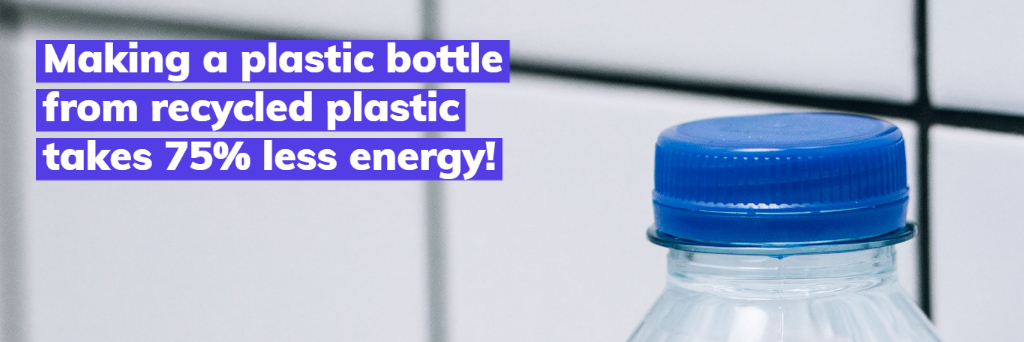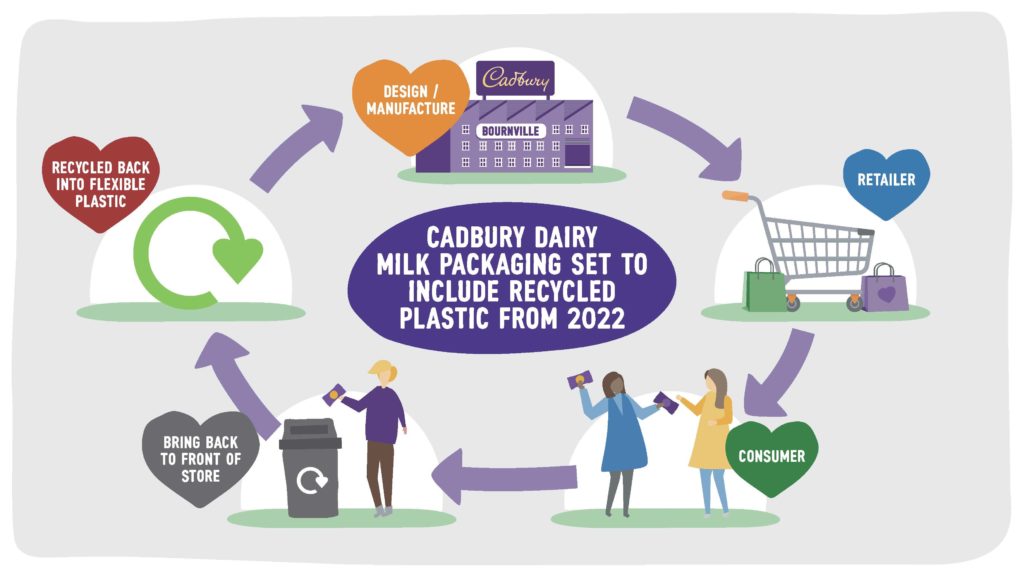
In recent years, much of the plastic packaging we buy has changed to include more recycled plastic. In fact, many brands run advertising campaigns about these changes to their packaging and the resulting environmental benefits.
But what does the amount of recycled plastic in packaging mean for us and why is it important for our planet?
Recycled plastic in packaging is plastic which has come from recycled materials. For example, plastic bottles that we recycle at home are sorted, cleaned, melted and made back into plastic bottles or other items. Sometimes you might see information on a product that says (for example) 100% recycled content, which means that the packaging has been made using 100% sourced recycled plastic.
This provides many benefits to the environment. Almost all virgin plastic is derived from fossil fuels, and the process of manufacturing plastic creates hundreds of millions of tonnes of greenhouse gases every year. The more virgin plastic we make, the more fossil fuels we need, the more we contribute to climate change. We need to remove plastic where we can (where it doesn’t lead to other environmental impacts) but where we can’t, using recycled materials is important. In fact, making a plastic bottle from recycled plastic takes 75% less energy!
Because of the positive impact on the environment, a group of UK leading brands, retailers, governments and NGOs have joined forces through The UK Plastics Pact with an aim to make all plastic packaging contain a minimum of 30% recycled plastic by 2025. Progress is already being made, with the average percentage of recycled plastic in packaging having doubled since 2018 to 18%. Incredibly, this equates to saving just over one million barrels of virgin oil and 140,000 tonnes of CO2ₑ !
Here are some great examples of progress being made:
Mondelez is to move its Cadbury Dairy Milk sharing bars into recycled plastic packaging. The new packs, which contain up to 30% recycled plastic, will be rolled out across more than 28 million sharing bars in 2022.

Hellman’s will transition its ‘squeezy’ range in the UK to bottles made from 100% recycled plastic. Nearly half of the range has already moved to the recycled plastic material, with plans for the full range to have switched by the end of 2022. Once complete it will save approximately 1,480 tonnes of virgin plastic every year!
PepsiCo has switched Pepsi Maxx and 7UP to 100% recycled content plastic bottles. The company aims to use 100% recycled plastic for all its ready-to-drink bottles in the UK by the end of 2022.

Businesses are also working to improve how recyclable their packaging is, so that more plastic gets recycled and stays in the system – for instance Sprite recently changed its green bottle to a transparent bottle so that it is easier to recycle into new packaging (read more about this here).
Retailers are also accepting more varied colours of recycled plastic to go into the packaging of items that they sell. You may have noticed that some supermarkets now sell microwave meals in trays that range from pink to purple, or maybe grey. The fact that the supermarkets are selling this packaging which varies in colour means that more plastic can stay in the system and recycled into more plastic packaging rather than get wasted.
While progress is happening, there are still challenges which the industry must address to meet the 30% recycled plastic content target:
Of utmost importance is ensuring that any recycled plastic is safe to be used and there are very strict requirements to ensure this happens. It is also very challenging to make plastic food bags and wrapping, such as bread bags and crisp packets using recycled content material. Technology is emerging to allow this and is being scaled up, but it takes time. Plastic bags and wrapping therefore are generally recycled into other products rather than plastic bags and wrapping items.
Why can’t all plastic packaging be made using 100% recycled content plastic?
There are lots of reasons for this.
- We’re not collecting all the plastic packing we use, so therefore there simply isn’t enough recycled content material available for all the plastic packaging that is produced.
- As with some other materials such as paper, plastic degrades in the recycling process, although technology is improving to reduce this.
- Recycled plastic is not just being used to manufacture new packaging, but a whole range of other products from clothes to cars to phones. This is good because it replaces the need for new virgin plastic but means that it is then not available to be turned back into plastic packaging.
So how can we make a difference at home?
It’s easy – simply recycle all the plastic that you can, – for instance by recycling only the items that are accepted by your local authority, and recycling plastic bags and wrapping at supermarkets.
The more plastic that we can recycle, the more recycled plastic will be available to go into new packaging. And ultimately, the better the impact for our planet.
To find out more about what you can recycle, and how to recycle in the best possible way, visit www.recyclenow.com
